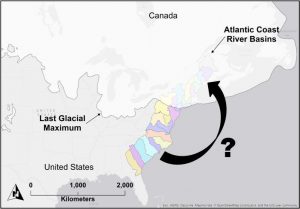
Did some freshwater mussels have advantageous traits that helped them populate northern rivers after the glaciers receded?
Climate change, appropriately, has been a widely studied topic by ecologists concerned about biological conservation and adaptation. Several studies have demonstrated how butterflies or birds or fishes may respond as their optimum temperatures shift toward the poles. But, what about animals that can’t move as well – those without wings or fins, or even legs?! I set out to learn more about that question in the context of freshwater mussels in Unionidae. These bivalves have a foot they use for burrowing and moving short distances in the stream bed, but rely on host fishes for long distance dispersal (this family of mussels has a parasitic larval stage, whereas other bivalves have free living larvae that can drift in currents). My latest article out this spring in Diversity and Distributions highlights how reproductive and dispersal traits that were successful in mussels’ post-glacial migration north offer hints to how they may cope with current warming.